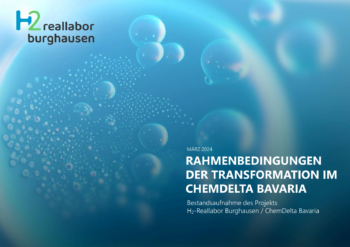How is green hydrogen defined according to the EU’s delegated act?
The Delegated Act (DA) for the definition of green hydrogen of the Renewable Energy Directive (RED) describes the criteria that electric power must fulfill for hydrogen produced from it to be designated as legally renewable. After briefly giving context on the DA in the European climate legislation, we summarize the possible sources for electricity that are laid out.
Long-awaited legal definition of green hydrogen
The Renewable Energy Directive (RED) sets targets at the European level for the reduction of greenhouse gas emissions in the transport sector [1]. To meet these targets, several alternative fuels are specified. In addition to biofuels and direct use of electricity in electric cars, these include synthetic fuels produced from renewable electricity, also called RFNBOs (Renewable Fuels of Non-Biological Origin).
Hydrogen, when produced from renewable electricity via electrolysis, also falls into this category. However, the criteria under which electricity can be considered renewable for this purpose were not set out in the latest version of RED II (2018) itself, but the decision was referred to the EU Commission to be set out in a Delegated Act (DA).
The publication of a first proposal, followed by a public consultation, took place in summer 2022 [2]. In the course of the revision of the RED, the EU Parliament also submitted a proposal in September 2022 [3].
Now, on Feb 13th, 2023, the EU Commission published the intended final version of the DA. After the pending (as of Feb 16th, 2023) approval of the EU Parliament and the Council of the EU, the definition of green hydrogen would then be cast into applicable law [4].

Four options for fully renewable electricity
The DA describes four ways to purchase electricity so that it can be used for the production of green hydrogen. If it fulfils one of these criteria, it is called ‘fully renewable electricity’
- Direct connection to a renewable energy (RE) plant: Electricity supplied to the electrolyzer from an RE installation without using the public grid is considered fully renewable. Connecting the electrolyzer and RE installation to the grid is possible but must be done through a smart metering system so that electricity consumption can be tracked. From 01.01.2028, the RE plant must also meet the condition of additionality, i.e. it must be constructed specifically for electrolyzer operation (see below). This is to avoid already existing RE capacity being used up for hydrogen production, which would lead to a higher demand of fossil power plants for the coverage of the conventional load.
- Purchase of grid electricity in a bidding zone with more than 90% RE share: In bidding zones with high renewable energy share, grid electricity may be used for the production of renewable hydrogen without further restrictions. It is sufficient if the renewable energy share in the bidding zone has exceeded the 90% threshold in one of the last five calendar years. However, the electrolyzer must not exceed a maximum number of operating hours determined by multiplying the renewable energy share in the electricity mix by the number of hours in a year.
- Purchase of renewable electricity through a Power Purchase Agreement (PPA): This involves a contract between the RE operator (or an aggregator) and the hydrogen producer to supply the produced electricity to the electrolyzer via the public grid. For the produced hydrogen to be considered renewable, the principles of temporal and geographical correlation must be met: For temporal correlation, the electricity must be consumed by the electrolyzer in the same hour it was injected (until Dec. 31, 2029: same month), or in an hour with day-ahead electricity price below a certain threshold (less than 20€/MWh or 0.36* price per ton CO2). Spatial correlation requires that the renewable energy plant is located in the same bidding zone as the electrolyzer, in an adjacent zone with higher electricity price, or an offshore bidding zone. Further, as in the case of direct connection, the principle of additionality is required in the PPA case, unless grid emission intensity is lower than 64.8 g CO2,e per kWh.
- Electricity consumption that avoids the shutdown of a RE plant for a redispatch measure: If the current situation on the electricity market leads to an overload of the transmission capacity of the electricity grid, the grid operator can order a redispatch. In this case, a power plant upstream of the grid bottleneck is downward dispatched, whereas another power plant downstream of the grid bottleneck is ordered to increase generation. If a RE plan would be downward dispatched for this purpose, the corresponding amount of electricity can be consumed by an electrolyzer instead and counts as fully renewable for RFNBO production. This is to ensure the best possible use of available RE capacity.
To fulfill the principle of additionality, after a transition period until Jan 1st, 2028, RE plants whose electricity is used via direct line or PPA must not have commenced operation more than three years before the electrolyzer, a period intended to account for uncertainties in the planning and permitting process for electrolyzers. In addition, they must not have received government subsidies for construction or operation, unless the RE installation underwent a repowering since the subsidy was received. Electrolyzer capacity added to an electrolyzer site less than three years after commissioning is considered to have entered service concurrently with the site.
In addition to the options described above, it is possible to generate hydrogen from grid electricity. In this case, electricity is considered renewable to a proportion equal to the share of RE in the electricity mix. It is also possible to combine several supply options, which also results in proportional accounting.
A graphical overview of the options and their conditions is presented in the infographic figure 1.
Literature
[1] – RED II – https://eur-lex.europa.eu/legal-content/EN/TXT/HTML/?uri=CELEX:32018L2001&from=EN
[2] – Proposal for the DA – https://ec.europa.eu/info/law/better-regulation/have-your-say/initiatives/7046068-Production-of-renewable-transport-fuels-share-of-renewable-electricity-requirements-_en
[3] – Position of the EU parliament on the revision of the RED II – https://www.europarl.europa.eu/doceo/document/TA-9-2022-0317_EN.html#title1
[4] – Published version of the DA – https://energy.ec.europa.eu/delegated-regulation-union-methodology-rnfbos_en

